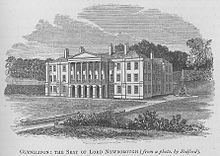Nationality British Died 1870 Role Architect | Name Edward Sr. Occupation Architect Children Edward Haycock (Junior) | |
 | ||
Alma mater A pupil of Sir Jeffrey Wyattville Practice J H and E Haycock c1815-30 Structures Nanteos Mansion, Holy Trinity Church, Middleton in Chinbury | ||
Edward Haycock Sr. (29 July 1790 – 20 December 1870) was an architect working in the West Midlands and in Central and Southern Wales in the late Georgian and early Victorian periods.
Contents
Family and Social life
He was the grandson of William Haycock (1725–1802) of Shrewsbury and the son of John Hiram Haycock (1759–1830), who were architects and building contractors. Edward Haycock Senior joined the family business after 1810 and took control of the business after his father's death in 1830. He stopped working as a building contractor around 1845 and was joined by his son Edward Haycock Junior (1829/30-1882), who continued the architectural practice until about 1880. He married Mary Hatton on 13 February 1827 at St Sepulchre-without-Newgate, London. By her she had three sons and four daughters.

Haycock also played an active part in the political life of Shrewsbury as a Conservative: he sat on the council for thirty-four years, rose to become an alderman, and served as mayor in 1842. He was a friend of the Shrewsbury architect John Carline and also of Dr Robert Waring Darwin, the father of the naturalist Charles Darwin.
He died on 20 December 1870 at his home, The Priory, Shrewsbury, aged 80 and was buried in St Chad's churchyard.
"Haycock Way", linking Shrewsbury's 20th century inner ring road to the Column roundabout at Abbey Foregate, is named for the family.
Architectural career
Edward Haycock received professional training in London under Sir Jeffrey Wyattville, exhibiting at the Royal Academy between 1808 and 1810. He then rejoined his father in the family building firm, working as builder and architect until about 1845, when he became a full-time architect. Work for the Gwynne family of Monachty led to the planning of Aberaeron. He was appointed County Surveyor of Shropshire from 1834 to 1866.
Haycock's Architectural Associations and Style
Haycock was a member of a group of architects, which included Thomas Farnolls Pritchard, Joseph Bromfield and John Carline, who established Shrewsbury as a major centre for architectural innovation in the later 18th and first half of the 19th century. This group gained many major architectural commissions in Shropshire and over much of Wales, despite competition from major London architects. Edward Haycock Snr specialised as a Gothic Revival architect.
His father had used the Ionic orders very effectively on the Shrewsbury Shirehall and Edward Haycock continued with the use of Ionic orders on his major projects as at Millichope Park, Glynllifon and Clytha Park. His churches tend to be more pedestrian, using a simplified Gothic, often with crocketed pinnacles on the towers. A departure from this is St Catherine's, Doddington, (a suburb of Whitchurch, Shropshire) 1836-7, which has an impressive Grecian revival facade.
Edward Haycock and the laying out of Aberaeron
Traditionally, it has been thought that the planning and layout of Aberaeron was by John Nash. The town was founded following an Act of Parliament in 1807, but it appears that town did not start to be laid out until about 1830. Edward Haycock was employed by Colonel A J Gwynne for supervising the building of houses and their layout in a grid plan around squares. In 1833, Samuel Lewis’s “Topographical Dictionary of Wales” records “Upwards of thirty new leases have been granted, pursuant to which several houses have been already built, and others are already in progress; a general post-office, a posting-house and an excellent hotel have been established". The Town Hall (1833–35), which later became the Cardiganshire County Hall, a typical building in Haycock’s style soon followed. The building of planned town continued until the 1850s with a house in Alban Square dated 1855. The posting house mentioned by Lewis could be the Castle and the hotel could be the Harbourmaster Hotel. Haycock achieved a consistency of style throughout the project which results in the attractive appearance of Aberaeron today.
